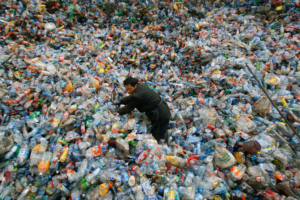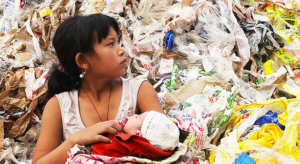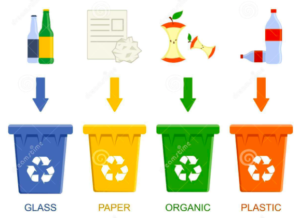NOTE: This blog post is also available as a Handout. See sidebar “Resources.”
I often get asked about China’s recent ruling to restrict incoming recyclables, which does indeed impact our communities on this side of the Pacific. So I put together some hopefully helpful info below…
 Excerpt from Notification 17-3880 (18 July 2017) by China to the World Trade Organization:
Excerpt from Notification 17-3880 (18 July 2017) by China to the World Trade Organization:
By the end of 2017, China will forbid the import of… plastics waste…, unsorted waste paper and waste textile materials… The reasons for urgent measure (Strictly Striking of Illegal “Foreign Garbage”): …we found large amounts of dirty wastes or even hazardous wastes mixed in the solid waste…
Worker sorting plastic bottles at a recycling center in China.
(Jie Zhao/Corbis via Getty Images)
AT ISSUE:
- Items that can’t be recycled – – such as broken glass amid paper, dirty diapers, decaying food, toxics, medical waste, etc. – – have often ended up in the recycling stream. Anything attached to a specifically collected (and compacted) commodity that doesn’t belong there creates contamination – – which reduces efficiency, destroys value, and leads to even greater waste. It’s why up to a third of recycling actually may end up in landfills.
 China’s earlier crackdown, Operation Green Fence in 2013, was aimed at improving the quality of imported waste, but their latest move (“National Sword,” excerpt above) bans 24 categories of waste outright, threatening some $5 billion in trade. Plastic immediately became the hardest material to move (as well as being the most indestructible pollutant).
China’s earlier crackdown, Operation Green Fence in 2013, was aimed at improving the quality of imported waste, but their latest move (“National Sword,” excerpt above) bans 24 categories of waste outright, threatening some $5 billion in trade. Plastic immediately became the hardest material to move (as well as being the most indestructible pollutant).- Most MRFs (Materials Recovery Facilities) have been sorting for a 3–5% contamination rate, but China has steadily reduced its allowable rate, from 4–5%, to 1.5% and now, for commodities not banned outright, the degree of contamination allowed has dropped to 0.5%. (MRFs that take in single-stream material report contamination levels of 15–25%.)
- In January 2017, China and Hong Kong accepted 77% of recovered plastic exports from North America. This year, that number dropped to 18%. Emerging markets in India, Malaysia, Thailand and Vietnam have taken some of the volume but a substantial amount of our plastic waste is still seeking a home and could end up in landfills (and oceans).
- Commodity prices have dropped and shipping prices increased.

- Chinese officials may have been spurred toward creating the latest restrictions by the release of Plastic China, a fierce documentary about the plastic-recycling industry, seen at Sundance film festival in January, 2017.
https://www.plasticchina.org >
LOCAL NOTE: At the time of China’s Operation Green Fence in 2013, Whatcom County, WA (especially Bellingham) acted to support its ongoing dual-stream (curbside separation) recycling collection, and began establishing other markets, such as Malaysia & Vietnam.That positioned the county to stand in much better stead now that the contamination standard has dropped even more. See Bellingham Herald’s article from July 1, 2018:
“Here’s why most Whatcom recycling isn’t ending up in landfills, despite China’s ban”
https://www.bellinghamherald.com/latest-news/article213193459.html#storylink=cpy
Why have we been shipping so much of our waste to China?

• North America does not have enough industrial capacity to process many types of recycled materials.
• The high cost of labor here makes current recycle sorting methods economically viable only in countries with low labor costs.
• Until now China was a well-established and easy-to-access market for a wide variety of recycled materials, with no incentive for us to change.
• A lot of the material being sent overseas was actually garbage, but with the previously low shipping costs and a minimum of inspections there was, again, not a lot of motivation to change.
What does this mean for citizens, municipalities, business?
With much more stringent regulation now, a lot of material will have to stay in North America for disposal, which, in a way, is probably a lot more efficient than shipping garbage around the globe. But consumers will see an increase in what they pay to have their recycling handled.
The main challenge is going to be reducing contamination in the recycling stream. This will take some difficult years to implement. There are notable, if demanding solutions:
- Increase innovation! For example, Subaru has developed a manufacturing process whereby imperfectly made bumpers can be quickly reground to make new bumpers.
- Find more local sources for recycled material. Help nearby businesses connect and share opportunities. Thanks to the internet, this is increasingly possible. For examples, search out Austin (TX) Materials Marketplace, Ontario (CA) Waste Exchange Network, California Materials Exchange (CalMAX).

- Invest in better sorting technology at recycling facilities.
- Pay more attention to your recycling and if an item is not clearly listed as acceptable for collection, err on the side of trashing it. Understand that only items that are empty, clean, and dry are recyclable.
- Educate and equip for cleaner disposal and better source separation, which for consumers might mean that instead of mixing paper, plastic, metal, etc., into one “single stream” bin, they use separate containers for paper, plastic, metal, and other materials. This can be a large change in both citizen’s mindsets and equipment/bins for many communities.
 While mixing plastic, paper & metal in one bin has advantages (notably convenience), the reality is that it does not create effectively recyclable material.
While mixing plastic, paper & metal in one bin has advantages (notably convenience), the reality is that it does not create effectively recyclable material.
Overall, source separation may require more work and upfront investment, but it will enable the continued operation of profitable recycling programs.
Many thanks for your good efforts!



